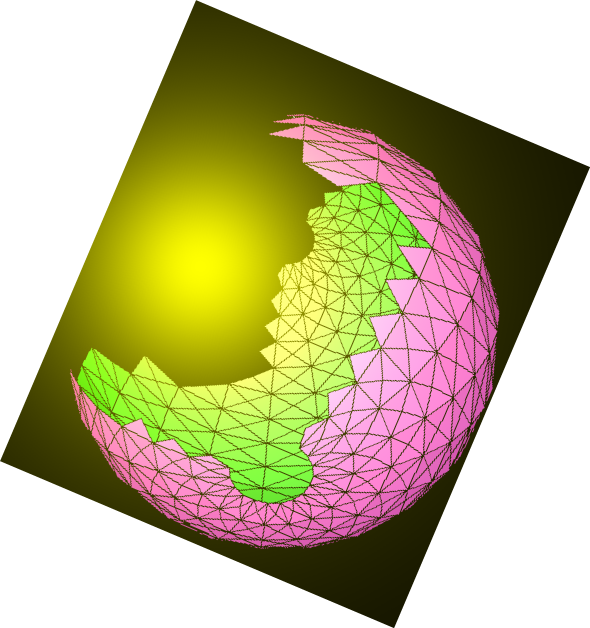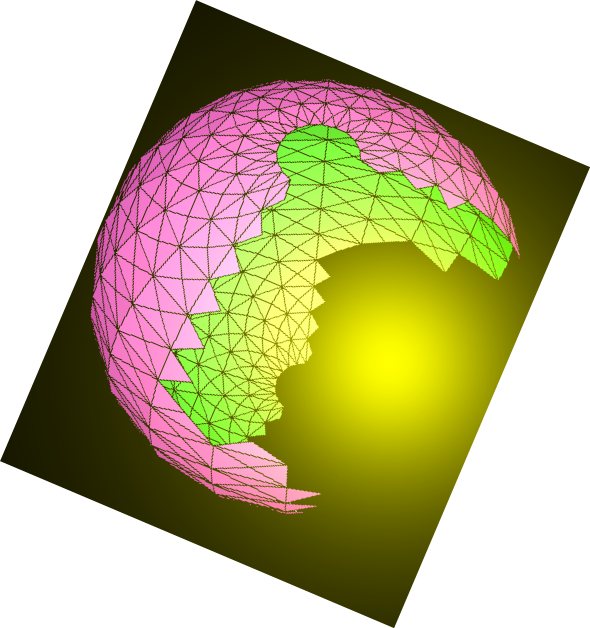
N.S.B. Cosmic Center
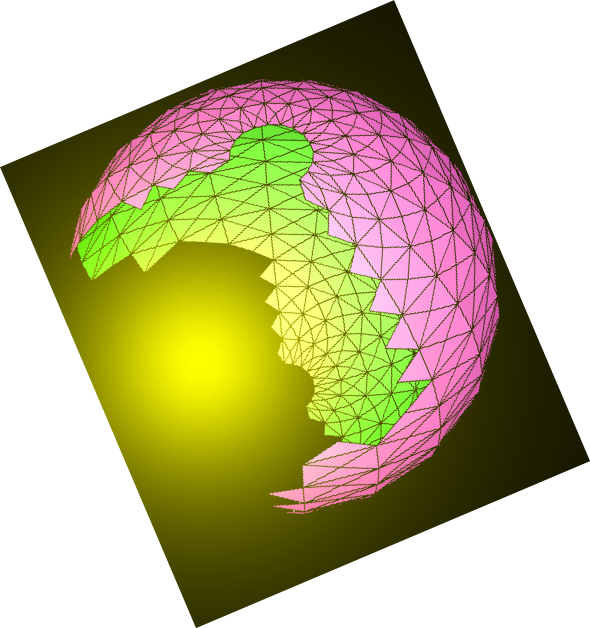
Literary Adventures
This page will take you into pieces of literature that are carefully selected for their great content at the literary, scientific, or philosophical level. A short selection will be presented in full. A long one will be divided into sections that will be refreshed regularly. Emphasis and highlights are mostly ours, not made by the original author.
Here is our current selection:
The Fairy-Land of Science (1878) by Arabella Burton Buckley
Lecture 2.
Sunbeams and the Work They Do.
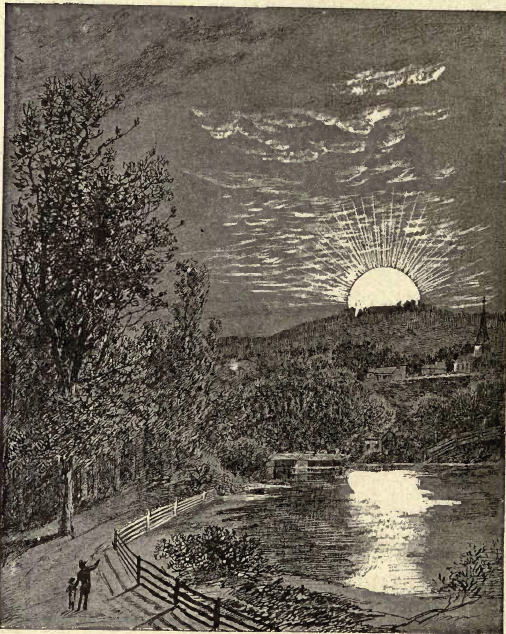
Who does not love the sunbeams, and feel brighter and merrier as he watches them playing on the wall, sparkling like diamonds on the ripples of the sea, or making bows of coloured light on the waterfall? Is not the sunbeam so dear to us that it has become a household word for all that is merry and gay? and when we want to describe the dearest, busiest little sprite amongst us, who wakes a smile on all faces wherever she goes, do we not call her the "
And yet how little even the wisest among us know about the nature and work of these bright messengers of the sun as they dart across space!
Did you ever wake quite early in the morning, when it was pitch-dark and you could see nothing, not even your own hand; and then lie watching as time went on till the light came gradually creeping in at the window? If you have done this you will have noticed that you can at first only just distinguish the dim outline of the furniture; then you can tell the difference between the white cloth on the table and the dark wardrobe beside it; then by degrees all the smaller details, the handles of the drawer, the pattern on the wall, and the different colours of all the objects in the room become clearer and clearer till at last you see all distinctly in broad daylight.
What has been happening here? and why have the things in the room become visible by such slow degrees? We say that the sun is rising, but we know very well that it is not the sun which moves, but that our earth has been turning slowly round, and bringing the little spot on which we live face to face with the great fiery ball, so that his beams can fall upon us.
Take a small globe, and stick a piece of black plaster over England, then let a lighted lamp represent the sun, and turn the globe slowly, so that the spot creeps round from the dark side away from the lamp, until it catches, first the rays which pass along the side of the globe, then the more direct rays, and at last stands fully in the blaze of the light. Just this was happening to our spot of the world as you lay in bed and saw the light appear; and we have to learn today what those beams are which fall upon us and what they do for us.
First we must learn something about the sun itself, since it is the starting-place of all the sunbeams. If the sun were a dark mass instead of a fiery one we should have none of these bright cheering messengers, and though we were turned face to face with him every day we should remain in one cold eternal night. Now you will remember we mentioned in the last lecture that it is heat which shakes apart the little atoms of water and makes them float up in the air to fall again as rain; and that if the day is cold they fall as snow, and all the water is turned into ice. But if the sun were altogether dark, think how bitterly cold it would be; far colder than the most wintry weather ever known, because in the bitterest night some warmth comes out of the earth, where it has been stored from the sunlight which fell during the day. But if we never received any warmth at all, no water would ever rise up into the sky, no rain ever fall, no rivers flow, and consequently no plants could grow and no animals live. All water would be in the form of snow and ice, and the earth would be one great frozen mass with nothing moving upon it.
So you see it becomes very interesting for us to learn what the sun is, and how he sends us his beams. How far away from us do you think he is? On a fine summer's day when we can see him clearly, it looks as if we had only to get into a balloon and reach him as he sits in the sky, and yet we know roughly that he is more than ninety-one millions of miles distant from our earth.
These figures are so enormous that you cannot really grasp them. But imagine yourself in an express train, travelling at the tremendous rate of sixty miles an hour and never stopping. At that rate, if you wished to arrive at the sun today you would have been obliged to start 171 years ago. That is, you must have set off in the early part of the reign of Queen Anne, and you must have gone on, never, never resting, through the reigns of George I., George II., and the long reign of George III., then through those of George IV., William IV., and Victoria, whirling on day and night at express speed, and at last, today, you would have reached the sun!
And when you arrived there, how large do you think you would find him to be? Anaxagoras, a learned Greek, was laughed at by all his fellow Greeks because he said that the sun was as large as the Peloponnesus, that is about the size of Middlesex. How astonished they would have been if they could have known that not only is he bigger than the whole of Greece, but more than a million times bigger than the whole world!
Our world itself is a very large place, so large that our own country looks only like a tiny speck upon it, and an express train would take nearly a month to travel round it. Yet even our whole globe is nothing in size compared to the sun, for it only measures 8000 miles across, while the sun measures more than 852,000.
Imagine for a moment that you could cut the sun and the earth each in half as you would cut an apple; then if you were to lay the flat side of the half-earth on the flat side of the half-sun it would take 106 such earths to stretch across the face of the sun. One of these 106 round spots on the diagram represents the size which our earth would look if placed on the sun; and they are so tiny compared to him that they look only like a string of minute beads stretched across his face. Only think, then, how many of these minute dots would be required to fill the whole of the inside of Fig 4, if it were a globe!
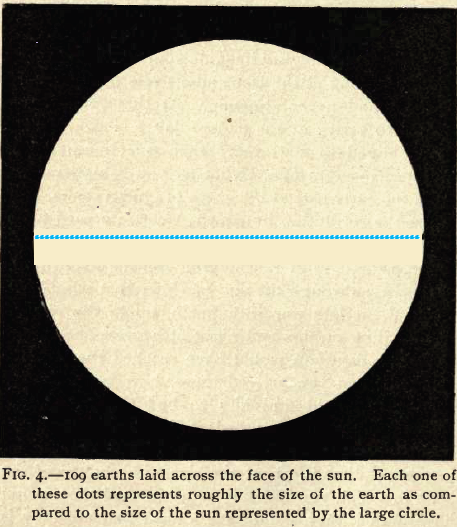
One of the best ways to form an idea of the whole size of the sun is to imagine it to be hollow, like an air-ball, and then see how many earths it would take to fill it. You would hardly believe that it would take one million, three hundred and thirty-one thousand globes the size of our world squeezed together. Just think, if a huge giant could travel all over the universe and gather worlds, all as big as ours, and were to make first a heap of merely ten such worlds, how huge it would be! Then he must have a hundred such heaps of ten to make a thousand worlds; and then he must collect again a thousand times that thousand to make a million, and when he had stuffed them all into the sun-ball he would still have only filled three-quarters of it!
After hearing this you will not be astonished that such a monster should give out an enormous quantity of light and heat; so enormous that it is almost impossible to form any idea of it. Sir John Herschel has, indeed, tried to picture it for us. He found that a ball of lime with a flame of oxygen and hydrogen playing round it (such as we use in magic lanterns and call oxy-hydrogen light) becomes so violently hot that it gives the most brilliant artificial light we can get--such that you cannot put your eye near it without injury. Yet if you wanted to have a light as strong as that of our sun, it would not be enough to make such a lime-ball as big as the sun is. No, you must make it as big as 146 suns, or more than 146,000,000 times as big as our earth, in order to get the right amount of light. Then you would have a tolerably good artificial sun; for we know that the body of the sun gives out an intense white light, just as the lime-ball does, and that, like it, it has an atmosphere of glowing gases round it.
But perhaps we get the best idea of the mighty heat and light of the sun by remembering how few of the rays which dart out on all sides from this fiery ball can reach our tiny globe, and yet how powerful they are. Look at the globe of a lamp in the middle of the room, and see how its light pours out on all sides and into every corner; then take a grain of mustard-seed, which will very well represent the comparative size of our earth, and hold it up at a distance from the lamp. How very few of all those rays which are filling the room fall on the little mustard-seed, and just so few does our earth catch of the rays which dart out from the sun. And yet this small quantity (1/2000-millionth part of the whole) does nearly all the work of our world.**
In order to see how powerful the sun's rays are, you have only to take a magnifying glass and gather them to a point on a piece of brown paper, for they will set the paper alight. Sir John Herschel tells us that at the Cape of Good Hope the heat was even so great that he cooked a beefsteak and roasted some eggs by merely putting them in the sun, in a box with a glass lid! Indeed, just as we should all be frozen to death if the sun were cold, so we should all be burnt up with intolerable heat if his fierce rays fell with all their might upon us. But we have an invisible veil protecting us, made--of what do you think? Of those tiny particles of water which the sunbeams draw up and scatter in the air, and which, as we shall see in Lecture IV., cut off part of the intense heat and make the air cool and pleasant for us.
We have now learnt something of the distance, the size, the light, and the heat of the sun--the great source of the sunbeams. But we are as yet no nearer the answer to the question, What is a sunbeam? how does the sun touch our earth?
Now suppose I wish to touch you from this platform where I stand, I can do it in two ways. Firstly, I can throw something at you and hit you--in this case a thing will have passed across the space from me to you. Or, secondly, if I could make a violent movement so as to shake the floor of the room, you would feel a quivering motion; and so I should touch you across the whole distance of the room. But in this case no thing would have passed from me to you but a movement or wave, which passed along the boards of the floor. Again, if I speak to you, how does the sound reach your ear? Not by anything being thrown from my mouth to your ear, but by the motion of the air. When I speak I agitate the air near my mouth, and that makes a wave in the air beyond, and that one, another, and another (as we shall see more fully in Lecture VI.), till the last wave hits the drum of your ear.
Thus we see there are two ways of touching anything at a distance; 1st, by throwing some thing at it and hitting it; 2nd, by sending a movement or wave across to it, as in the case of the quivering boards and the air.
Now the great natural philosopher Newton thought that the sun touched us in the first of these ways, and that sunbeams were made of very minute atoms of matter thrown out by the sun, and making a perpetual cannonade on our eyes. It is easy to understand that this would make us see light and feel heat, just as a blow in the eye makes us see stars, or on the body makes it feel hot: and for a long time this explanation was supposed to be the true one. But we know now that there are many facts which cannot be explained on this theory, though we cannot go into them here. What we will do, is to try and understand what now seems to be the true explanation of a sunbeam.
About the same time that Newton wrote, a Dutchman, named Huyghens, suggested that light comes from the sun in tiny waves, travelling across space much in the same way as ripples travel across a pond. The only difficulty was to explain in what substance these waves could be travelling: not through water, for we know that there is no water in space--nor through air, for the air stops at a comparatively short distance from our earth. There must then be something filling all space between us and the sun, finer than either water or air.
And now I must ask you to use all your imagination, for I want you to picture to yourselves something quite as invisible as the Emperor's new clothes in Andersen's fairy-tale, only with this difference, that our invisible something is very active; and though we can neither see it nor touch it we know it by its effects. You must imagine a fine substance filling all space between us and the sun and the stars. A substance so very delicate and subtle, that not only is it invisible, but it can pass through solid bodies such as glass, ice, or even wood or brick walls. This substance we call "
Now if you can imagine this ether filling every corner of space, so that it is everywhere and passes through everything, ask yourselves, what must happen when a great commotion is going on in one of the large bodies which float in it? When the atoms of the gases round the sun are clashing violently together to make all its light and heat, do you not think they must shake this ether all around them? And then since the ether stretches on all sides from the sun to our earth and all other planets, must not this quivering travel to us, just as the quivering of the boards would from me to you? Take a basin of water to represent the ether, and take a piece of potassium like that which we used in our last lecture, and hold it with a pair of nippers in the middle of the water. You will see that as the potassium hisses and the flame burns round it, they will make waves which will travel all over the water to the edge of the basin and you can imagine how in the same way waves travel over the ether from the sun to us.
Straight away from the sun on all sides, never stopping, never resting, but chasing after each other with marvellous quickness, these tiny waves travel out into space by night and by day. When our spot of the earth where England lies is turned away from them and they cannot touch us, then it is night for us, but directly England is turned so as to face the sun, then they strike on the land, and the water, and warm it; or upon our eyes, making the nerves quiver so that we see light. Look up at the sun and picture to yourself that instead of one great blow from a fist causing you to see stars for a moment, millions of tiny blows from these sun-waves are striking every instant on your eye; then you will easily understand that this would cause you to see a constant blaze of light.
But when the sun is away, if the night is clear we have light from the stars. Do these then too make waves all across the enormous distance between them and us? Certainly they do, for they too are suns like our own, only they are so far off that the waves they send are more feeble, and so we only notice them when the sun's stronger waves are away.
But perhaps you will ask, if no one has ever seen these waves nor the ether in which they are made, what right have we to say they are there? Strange as it may seem, though we cannot see them we have measured them and know how large they are, and how many can go into an inch of space. For as these tiny waves are running on straight forward through the room, if we put something in their way, they will have to run round it; and if you let in a very narrow ray of light through a shutter and put an upright wire in the sunbeam, you actually make the waves run round the wire just as water runs round a post in a river; and they meet behind the wire, just as the water meets in a V shape behind the post. Now when they meet, they run up against each other, and here it is we catch them. For if they meet comfortably, both rising up in a good wave, they run on together and make a bright line of light; but if they meet higgledy-piggledy, one up and the other down, all in confusion, they stop each other, and then there is no light, but a line of darkness. And so behind your piece of wire you can catch the waves on a piece of paper, and you will find they make dark and light lines one side by side with the other, and by means of these bands it is possible to find out how large the waves must be. This question is too difficult for us to work it out here, but you can see that large waves will make broader light and dark bands than small ones will, and that in this way the size of the waves may be measured.
And now how large do you think they turn out to be? So very, very tiny that about fifty thousand waves are contained in a single inch of space! I have drawn on the board the length of an inch, and now I will measure the same space in the air between my finger and thumb. Within this space at this moment there are fifty thousand tiny waves moving up and down! I promised you we would find in science things as wonderful as in fairy tales. Are not these tiny invisible messengers coming incessantly from the sun as wonderful as any fairies? and still more so when, as we shall see presently, they are doing nearly all the work of our world.
We must next try to realize how fast these waves travel. You will remember that an express train would take 171 years to reach us from the sun; and even a cannon-ball would take from ten to thirteen years to come that distance. Well, these tiny waves take only seven minutes and a half to come the whole 91 millions of miles. The waves which are hitting your eye at this moment are caused by a movement which began at the sun only 7-1/2 minutes ago. And remember, this movement is going on incessantly, and these waves are always following one after the other so rapidly that they keep up a perpetual cannonade upon the pupil of your eye. So fast do they come that about 608 billion waves enter your eye in one single second. I do not ask you to remember these figures; I only ask you to try and picture to yourselves these infinitely tiny and active invisible messengers from the sun, and to acknowledge that light is a fairy thing.
But we do not yet know all about our sunbeam. See, I have here a piece of glass with three sides, called a prism. If I put it in the sunlight which is streaming through the window, what happens? Look! on the table there is a line of beautiful colours. I can make it long or short, as I turn the prism, but the colours always remain arranged in the same way. Here at my left hand is the red, beyond it orange, then yellow, green, blue, indigo or deep blue, and violet, shading one into the other all along the line. We have all seen these colours dancing on the wall when the sun has been shining brightly on the cut-glass pendants of the chandelier, and you may see them still more distinctly if you let a ray of light into a darkened room, and pass it through the prism as in the diagram (Fig. 7). What are these colours? Do they come from the glass? No; for you will remember to have seen them in the rainbow, and in the soap-bubble, and even in a drop of dew or the scum on the top of a pond. This beautiful coloured line is only our sunbeam again, which has been split up into many colours by passing through the glass, as it is in the rain-drops of the rainbow and the bubbles of the scum of the pond.
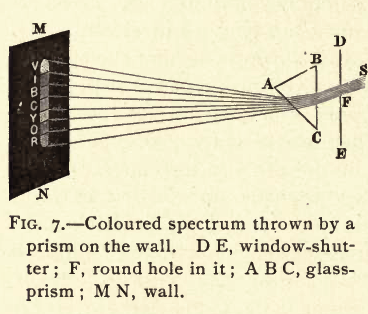
Till now we have talked of the sunbeam as if it were made of only one set of waves, but in truth it is made of many sets of waves of different sizes, all travelling along together from the sun. These various waves have been measured, and we know that the waves which make up red light are larger and more lazy than those which make violet light, so that there are only thirty-nine thousand red waves in an inch, while there are fifty-seven thousand violet waves in the same space.
How is it then, that if all these different waves, making different colours, hit on our eye, they do not always make us see coloured light? Because, unless they are interfered with, they all travel along together, and you know that all colours, mixed together in proper proportion, make white.
I have here a round piece of cardboard, painted with the seven colours in succession several times over. When it is still you can distinguish them all apart, but when I whirl it quickly round--see!--the cardboard looks quite white, because we see them all so instantaneously that they are mingled together. In the same way light looks white to you, because all the different coloured waves strike on your eye at once. You can easily make one of these cards for yourselves, only the white will always look dirty, because you cannot get the colours pure.
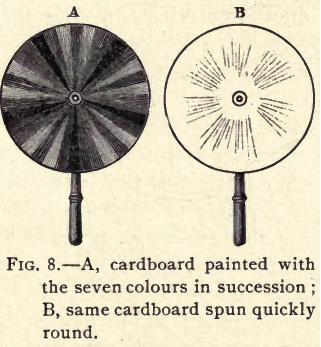
Now, when the light passes through the three-sided glass or prism, the waves are spread out, and the slow, heavy, red waves lag behind and remain at the lower end R of the coloured line on the wall (Fig. 7), while the rapid little violet waves are bent more out of their road and run to V at the farther end of the line; and the orange, yellow, green, blue, and indigo arrange themselves between, according to the size of their waves.
And now you are very likely eager to ask why the quick waves should make us see one colour, and the slow waves another. This is a very difficult question, for we have a great deal still to learn about the effect of light on the eye. But you can easily imagine that colour is to our eye much the same as music is to our ear. You know we can distinguish different notes when the air-waves play slowly or quickly upon the drum of the ear (as we shall see in Lecture VI.), and somewhat in the same way the tiny waves of the ether play on the retina or curtain at the back of our eye, and make the nerves carry different messages to the brain: and the colour we see depends upon the number of waves which play upon the retina in a second.
Do you think we have now rightly answered the question--What is a sunbeam? We have seen that it is really a succession of tiny rapid waves, travelling from the sun to us across the invisible substance we call "
What work do the sunbeams do for us?
They do two things--they give us light and heat. It is by means of them alone that we see anything. When the room was dark you could not distinguish the table, the chairs, or even the walls of the room. Why? Because they had no light-waves to send to your eye. But as the sunbeams began to pour in at the window, the waves played upon the things in the room, and when they hit them they bounded off them back to your eye, as a wave of the sea bounds back from a rock and strikes against a passing boat. Then, when they fell upon your eye, they entered it and excited the retina, and the nerves, and the image of the chair or the table was carried to your brain. Look around at all the things in this room. Is it not strange to think that each one of them is sending these invisible messengers straight to your eye as you look at it; and that you see me, and distinguish me from the table, entirely by the kind of waves we each send to you?
Some substances send back hardly any waves of light, but let them all pass through them, and thus we cannot see them. A pane of clear glass, for instance, lets nearly all the light-waves pass through it, and therefore you often cannot see that the glass is there, because no light-messengers come back to you from it. Thus people have sometimes walked up against a glass door and broken it, not seeing it was there. Those substances are transparent which, for some reason unknown to us, allow the ether waves to pass through them without shaking the atoms of which the substance is made. In clear glass, for example, all the light-waves pass through without affecting the substance of the glass; while in a white wall the larger part of the rays are reflected back to your eye, and those which pass into the wall, by giving motion to its atoms lose their own vibrations.
Into polished shining metal the waves hardly enter at all, but are thrown back from the surface; and so a steel knife or a silver spoon are very bright, and are clearly seen. Quicksilver is put at the back of looking-glasses because it reflects so many waves. It not only sends back those which come from the sun, but those, too, which come from your face. So, when you see yourself in a looking-glass, the sun-waves have first played on your face and bounded off from it to the looking-glass; then, when they strike the looking-glass, they are thrown back again on to the retina of your eye, and you see your own face by means of the very waves you threw off from it an instant before.
But the reflected light-waves do more for us than this. They not only make us see things, but they make us see them in different colours. What, you will ask, is this too the work of the sunbeams? Certainly; for if the colour we see depends on the size of the waves which come back to us, then we must see things coloured differently according to the waves they send back. For instance, imagine a sunbeam playing on a leaf: part of its waves bound straight back from it to our eye and make us see the surface of the leaf, but the rest go right into the leaf itself, and there some of them are used up and kept prisoners. The red, orange, yellow, blue, and violet waves are all useful to the leaf, and it does not let them go again. But it cannot absorb the green waves, and so it throws them back, and they travel to your eye and make you see a green colour. So when you say a leaf is green, you mean that the leaf does not want the green waves of the sunbeam, but sends them back to you. In the same way the scarlet geranium rejects the red waves; this table sends back brown waves; a white tablecloth sends back nearly the whole of the waves, and a black coat scarcely any. This is why, when there is very little light in the room, you can see a white tablecloth while you would not be able to distinguish a black object, because the few faint rays that are there, are all sent back to you from a white surface.
Is it not curious to think that there is really no such thing as colour in the leaf, the table, the coat, or the geranium flower, but we see them of different colours because, for some reason, they send back only certain coloured waves to our eye?
Wherever you look, then, and whatever you see, all the beautiful tints, colours, lights, and shades around you are the work of the tiny sun-waves.
Again, light does a great deal of work when it falls upon plants. Those rays of light which are caught by the leaf are by no means idle; we shall see in Lecture VII that the leaf uses them to digest its food and make the sap on which the plant feeds.
We all know that a plant becomes pale and sickly if it has not sunlight, and the reason is, that without these light-waves it cannot get food out of the air, nor make the sap and juices which it needs. When you look at plants and trees growing in the beautiful meadows; at the fields of corn, and at the lovely landscape, you are looking on the work of the tiny waves of light, which never rest all through the day in helping to give life to every green thing that grows.
So far we have spoken only of light; but hold your hand in the sun and feel the heat of the sunbeams, and then consider if the waves of heat do not do work also. There are many waves in a sunbeam which move too slowly to make us see light when they hit our eye, but we can feel them as heat, though we cannot see them as light. The simplest way of feeling heat-waves is to hold a warm iron near your face. You know that no light comes from it, yet you can feel the heat-waves beating violently against your face and scorching it. Now there are many of these dark heat-rays in a sunbeam, and it is they which do most of the work in the world.
In the first place, as they come quivering to the earth, it is they which shake the water-drops apart, so that these are carried up in the air, as we shall see in the next lecture. And then remember, it is these drops, falling again as rain, which make the rivers and all the moving water on the earth. So also it is the heat-waves which make the air hot and light, and so cause it to rise and make winds and air-currents, and these again give rise to ocean-currents. It is these dark rays, again, which strike upon the land and give it the warmth which enables plants to grow. It is they also which keep up the warmth in our own bodies, both by coming to us directly from the sun, and also in a very roundabout way through plants. You will remember that plants use up rays of light and heat in growing; then either we eat the plants, or animals eat the plants and we eat the animals; and when we digest the food, that heat comes back in our bodies, which the plants first took from the sunbeam. Breathe upon your hand, and feel how hot your breath is; well, that heat which you feel, was once in a sunbeam, and has travelled from it through the food you have eaten, and has now been at work keeping up the heat of your body.
But there is still another way in which these plants may give out the heat-waves they have imprisoned. You will remember how we learnt in the first lecture that coal is made of plants, and that the heat they give out is the heat these plants once took in. Think how much work is done by burning coals. Not only are our houses warmed by coal fires and lighted by coal gas, but our steam-engines and machinery work entirely by water which has been turned into steam by the heat of coal and coke fires; and our steamboats travel all over the world by means of the same power. In the same way the oil of our lamps comes either from olives, which grow on trees; or from coal and the remains of plants and animals in the earth. Even our tallow candles are made of mutton fat, and sheep eat grass; and so, turn which way we will, we find that the light and heat on our earth, whether they come from fires, or candles, or lamps, or gas, and whether they move machinery, or drive a train, or propel a ship, are equally the work of the invisible waves of ether coming from the sun, which make what we call a sunbeam.
Lastly, there are still some hidden waves which we have not yet mentioned, which are not useful to us either as light or heat, and yet they are not idle.
Before I began this lecture, I put a piece of paper, which had been dipped in
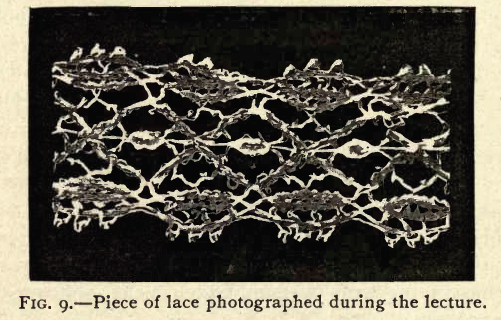
The action of the photographic rays was well known long before I delivered these lectures, twenty years ago.
But since some still more marvellous and wonder-working rays have been discovered. These rays were studied and their curious action first shown by Professor Röntgen, of Würzburg ; therefore they are sometimes called the Röntgen rays, and sometimes the X-rays, because X stands in algebra for an unknown quantity; and although we know how these rays act, we do not yet know what they are, except that they are not ordinary forms of heat, light, or electricity.
They are produced by inserting platinum wires, one at each end, into a glass tube from which the air has been withdrawn so as to make almost a perfect vacuum. These wires are then connected with an electric battery, and a current of electricity at very high pressure is passed through the tube, producing a bluish-green light. But just before the current passes out at the other end of the tube, there is a dark space seen in which there is no bluish-green light. It is in this space that the X-rays lie. They are quite invisible in themselves, but if a screen is placed in their road, painted over with a fluorescent substance (such as the luminous paint put on matchbox cases), they set up vibrations in the paint which cause it to glow brilliantly.
Now comes the wonderful part. If you make this screen of cardboard or wood, and turn the painted side away from the vacuum tube, it will still glow brightly. And if you then put your hand between the tube and the screen you will see the bones of your hand on the glowing paint, exactly as shown in Fig. 10. The X-rays will have passed almost entirely through the flesh of your hand and through the wood or cardboard, throwing only a very faint shadow upon the screen, while the bones will have stopped them altogether, and so cast a deep black shadow. You will see that the ring on the finger also casts a deep shadow, showing that the X-rays could not pass through the gold.
I have done this myself and seen the bones of my own hand, and I have made an equally strange experiment. I held a stout leather bag between the tube and the screen, and lo! the leather of the bag became only a very faint shadow, like the flesh of my hand had done, and I saw upon the screen the metal framework of the bag, and within it a bunch of keys, an opera glass, and several coins which were shut up inside the bag.
The reason of all these marvels is that the X-rays will pass through flesh, wood, leather, paper, cardboard, even through a pack of cards, and through several other substances which entirely stop the ordinary rays of light and heat. But they will not pass through bone nor through heavy metals. Therefore the framework of the bag, the brass tubes of the opera glass, the coins, and the bunch of keys stopped them altogether and threw deep shadows. It is not necessary to make these rays visible in order to enable them to do work. If you take the fluorescent screen away and put in its place a properly prepared photographic plate, wrapped in black paper to keep out the lightrays, or in a wooden box, and place your hand again in front of the tube, the X-rays will pass through your flesh and through the black paper, or the wood, and cast the shadow of your bones and ring upon the plate, altering the chemicals everywhere except where this shadow lies. Then when the plate is taken out, properly developed, and printed on paper you will have the image shown in Fig. 10 just as we had the impression of the lace just now.
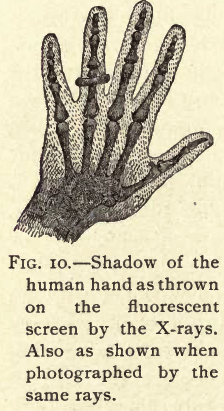
Is not this like a magician's story ! And it has the advantage of being useful to mankind, for surgeons now use these X-rays to see the exact spot where bullets or other solid objects are buried in the flesh of people's bodies, so that they can cut them out. These rays have several other curious properties, and we do not yet know half the wonders they may reveal to us, but they teach us how much more we have still to learn about sunbeams and their work.
And now, tell me, may we not honestly say, that the invisible waves which make our sunbeams, are wonderful fairy messengers as they travel eternally and unceasingly across space, never resting, never tiring in doing the work of our world? Little as we have been able to learn about them in one short hour, do they not seem to you worth studying and worth thinking about, as we look at the beautiful results of their work? The ancient Greeks worshipped the sun, and condemned to death one of their greatest philosophers, named Anaxagoras, because he denied that it was a god. We can scarcely wonder at this when we see what the sun does for our world; but we know that it is a huge globe made of gases and fiery matter, and not a god. We are grateful for the sun instead of to him, and surely we shall look at him with new interest, now that we can picture his tiny messengers, the sunbeams, flitting over all space, falling upon our earth, giving us light to see with, and beautiful colours to enjoy, warming the air and the earth, making the refreshing rain, and, in a word, filling the world with life and gladness.
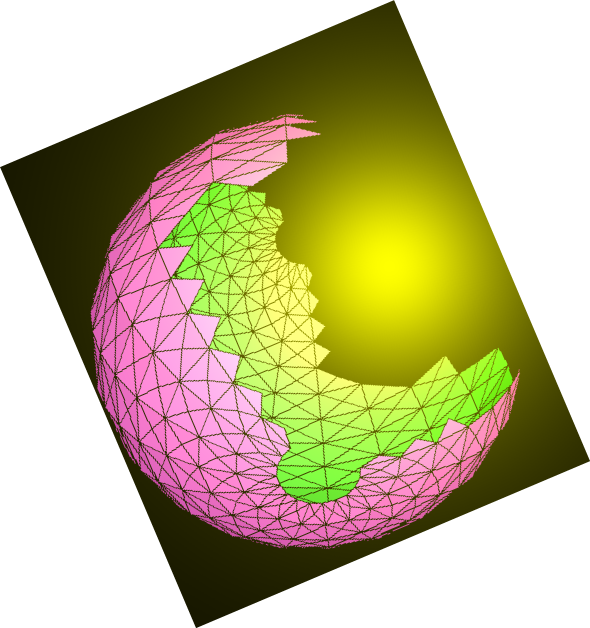
Home
N.S.B. Cosmic Center
